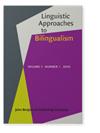跨语言影响如何影响持续时间在产生和感知纠正性和非纠正性焦点类型中的使用
IF 1.8
2区 文学
0 LANGUAGE & LINGUISTICS
引用次数: 0
摘要
摘要说话者将纠正焦点作为纠正交际中误解的一种明确方式。我们研究沉浸式接触节奏不同的语言是否会影响持续时间的产生和感知,作为纠正性和非纠正性焦点的线索。我们测试了28个以乌尔都语为母语的人和64个以乌尔都语为母语的听众,其中一半人住在德国,把德语作为第二语言,另一半住在巴基斯坦。德语是重音计时语言,使用头部突出标记,大量使用时长标记纠正焦点;乌尔都语是音节计时语言,使用边缘突出标记,使用时长标记焦点类型与德语不同。结果表明,多数语言德语对乌尔都语焦点加工的影响不同:在生产方面,焦点标记不受居住国的影响,而在感知方面,生活在德国的乌尔都语使用者比生活在巴基斯坦的乌尔都语使用者对纠正焦点语境中的持续时间更敏感。我们将其分析为跨语言影响,并认为与重音时间、头部突出的多数语言(这里:德语)接触会影响母语乌尔都语在感知上的提示权重,但在生产上(尚未)影响提示权重。本文章由计算机程序翻译,如有差异,请以英文原文为准。
How cross–linguistic influence affects the use of duration in the production and perception of corrective and non–corrective focus types
Abstract Speakers use corrective focus as an explicit way to correct misunderstandings in communication. We investigate whether immersive contact with a rhythmically different language affects the production and perception of duration as a cue to corrective and non–corrective focus. We tested twenty-eight native speakers and sixty-four native listeners of Urdu, half of whom lived in Germany and used German as a second language, and half lived in Pakistan. German is a stress–timed language with head–prominence marking and makes intensive use of duration to mark corrective focus, while Urdu is a syllable–timed language with edge–prominence marking, which uses duration differently from German to mark focus types. Results showed that the majority language, German, affected focus processing in Urdu differently across modalities: In production, focus marking was not affected by country of residence, while in perception, Urdu speakers living in Germany were more sensitive to duration in the corrective focus context than Urdu speakers in Pakistan. We analyze this as cross–linguistic influence and argue that contact with a stress–timed, head–prominence majority language (here: German) affects the cue weighting in the native language Urdu in perception but not (yet) in production.
求助全文
通过发布文献求助,成功后即可免费获取论文全文。
去求助
来源期刊

Linguistic Approaches To Bilingualism
Social Sciences-Linguistics and Language
CiteScore
3.20
自引率
9.10%
发文量
24
期刊介绍:
LAB provides an outlet for cutting-edge, contemporary studies on bilingualism. LAB assumes a broad definition of bilingualism, including: adult L2 acquisition, simultaneous child bilingualism, child L2 acquisition, adult heritage speaker competence, L1 attrition in L2/Ln environments, and adult L3/Ln acquisition. LAB solicits high quality articles of original research assuming any cognitive science approach to understanding the mental representation of bilingual language competence and performance, including cognitive linguistics, emergentism/connectionism, generative theories, psycholinguistic and processing accounts, and covering typical and atypical populations.
 求助内容:
求助内容: 应助结果提醒方式:
应助结果提醒方式:


